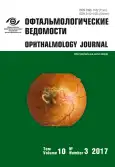Our experience in visual functions' improvement in patiens with “wet” age-related macular degeneration at switching from one anti-VEGF agent to another
- Authors: Korotkikh S.A.1, Bobykin E.V.1
-
Affiliations:
- Ural State Medical University
- Issue: Vol 10, No 3 (2017)
- Pages: 67-73
- Section: Articles
- URL: https://journals.rcsi.science/ov/article/view/7197
- DOI: https://doi.org/10.17816/OV10367-73
- ID: 7197
Cite item
Full Text
Abstract
Purpose. To assess mean changes in visual acuity, central retinal thickness and macular volume as well as to determine the duration of clinical choroidal neovascularization inactivity after single aflibercept injection in neovascular age-related macular degeneration (nAMD) patients switched from ranibizumab (preliminary date). Methods. Open-label prospective study. The study enrolled 23 patients with nAMD previously treated with ranibizumab.
Results. Mean age of patients was 70.5 years, 16 were women. Mean number of ranibizumab injections given prior to switching to aflibercept was 8.7. After single aflibercept inravitreal injection mean visual acuity has significantly improved from 0.40 to 0.47 Snellen chart. Mean central retinal thickness has significantly reduced from 323.1 to 246.9 μm and mean macular volume has significantly reduced from 7.71 to 6.74 mm3. Duration of choroidal neovascularization (CNV) inactivity was 2.91 months.
Conclusion. Single aflibercept intravitreal injection has resulted in significant visual gain as well as in significant central retinal thickness (CRT) and macular volume reduction. This provides evidence of aflibecept efficacy in nAMD patients previously treated with anti-VEGF. Duration of CNV inactivity provides clinical data supporting aflibercept injection every 8 weeks in nAMD patients.
Full Text
##article.viewOnOriginalSite##About the authors
Sergey A. Korotkikh
Ural State Medical University
Author for correspondence.
Email: med@usma.ru
MD, PhD, Professor, Head of the Department of Ophthalmology
Russian Federation, YekaterinburgEvgeniy V. Bobykin
Ural State Medical University
Email: oculist.ev@gmail.com
MD, PhD, Professor Associate, Assistant Professor of the Department of Ophthalmology
YekaterinburgReferences
- Jacob J, Brié H, Leys A, et al. Six-year outcomes in neovascular age-related macular degeneration with ranibizumab. Int J Ophthalmol. 2017;10(1):81-90. doi: 10.18240/ijo.2017.01.14.
- Rofagha S, Bhisitkul RB, Boyer DS, et al. Seven-year outcomes in ranibizumab-treated patients in ANCHOR, MARINA, and HORIZON: a multicenter cohort study (SEVEN-UP). Ophthalmology. 2013;120:2292-2299. doi: 10.1016/j.ophtha.2013.03.046.
- Коротких С.А., Бобыкин Е.В., Назарова Н.С., Мелехина Е.Е. Антиангиогенная терапия неоваскулярных заболеваний макулярной области (отдалённые результаты) // Вестник офтальмологии. – 2016. – Т. 132. – № 1. – С. 76–84. [Korotkikh SA, Bobykin EV, Nazarova NS, Melekhina EE. Long-term outcomes of anti-angiogenic therapy for macular neovascular disorders. Vestnik oftal’mologii. 2016;132(1):76-84. (In Russ.)]. doi: 10.17116/oftalma2016132176-84.
- Brown DM, et al. Ranibizumab versus verteporfin photodynamic therapy for neovascular age-related macular degeneration: Two-year results of the ANCHOR study. Ophthalmology. 2009;116:57-65. doi: 10.1016/j.ophtha.2008.10.018.
- Rosenfeld PJ, et al. Ranibizumab for neovascular age-related macular degeneration. N Engl J Med. 2006;355:1419-31. doi: 10.1056/NEJMoa054481.
- Holz FG, Tadayoni R, Beatty S, et al. Multi-Country Real-Life Experience of Anti-Vascular Endothelial Growth Factor Therapy for Wet Age-Related Macular Degeneration. Br J Ophthalmol. 2014;99(2): 220-226. doi: 10.1136/bjophthalmol-2014-305327.
- Schmidt-Erfurth U, et al. Efficacy and Safety of Monthly versus Quarterly Ranibizumab Treatment in Neovascular Age-related Macular Degeneration: The EXCITE Study. Ophthalmology. 2011;118:831-839. doi: 10.1016/j.ophtha.2010.09.004.
- Regillio CD, et al. Randomized, double-masked, sham-controlled trial of ranibizumab for neovascular age-related macular degeneration: PIER Study year 1. Am J Ophthalmol. 2008;145(2):239-248. doi: 10.1016/j.ajo.2007.10.004.
- Boyer DS, Heier JS, Brown DM, et al. A phase IIIb study to evaluate the safety of ranibizumab in subjects with neovascular age-related macular degeneration. Ophthalmology. 2009;116:1731-1739. doi: 10.1016/j.ophtha.2009.05.024.
- The CATT Research Group, Ranibizumab and bevacizumab for neovascular age-related macular degeneration. N Engl J Med. 2011;364(20):1897-1908. doi: 10.1056/NEJMoa1102673.
- Mitchell P, Korobelnik JF, et al. Ranibizumab (Lucentis) in neovascular age-related macular degeneration: evidence from clinical trials. Br J Ophthalmol. 2010 Jan;94(1):2-13. doi: 10.1136/bjo.2009.159160.
- Freund KB, Korobelnik JF, et al. Treat-and-extend regimens with anti-vegf agents in retinal diseases: A Literature review and consensus recommendations. Retina. 2015 Aug;35(8):1489-506. doi: 10.1097/IAE.0000000000000627.
- Yonekawa Y, et al. Conversion to aflibercept for chronic refractory or recurrent neovascular age-related macular degeneration. Am J Ophthalmol. 2013Jul;156(1):29-35.e2. doi: 10.1016/j.ajo.2013.03.030.
- VEGF Trap-Eye (aflibercept ophthalmic solution) briefing document. Ophthalmologic Drugs Advisory Committee. June 17, 2011. Tarrytown, NY: Regeneron Pharmaceuticals, Inc.; 2011.
- Papadopoulos N, Martin J, Ruan Q, et al. Binding and neutralization of vascular endothelial growth factor (VEGF) and related ligands by VEGF Trap, ranibizumab and bevacizumab. Angiogenesis. 2012;15(2):171-185. doi: 10.1007/s10456-011-9249-6.
- Stewart MW. Pharmacokinetics, pharmacodynamics and pre-clinical characteristics of ophthalmic drugs that bind VEGF. Expert Rev Clin Pharmacol. 2014;7(2):167-180. doi: 10.1586/17512433.2014.884458.
- Инструкция по медицинскому применению препарата «Эйлеа». Регистрационный номер: ЛП-003544-200117. [Medicine Directions of the drug “Eylea”. Registration number: LP-003544-200117. (In Russ.)]
- Rakic JM, Lambert V, Devy L, et al. Placental growth factor, a member of the VEGF family, contributes to the development of choroidal neovascularization. Invest Ophthalmol Vis Sci. 2003;44(7):3186-93. doi: 10.1167/iovs.02-1092.
- Hoeben A, Landuyt B, Highley MS, et al. Vascular endothelial growth factor and angiogenesis. Pharmacol Rev. 2004;56(4):549-80. doi: 10.1124/pr.56.4.3.
- Schmidt-Erfurth U, Kaiser PK, Korobelnik J-F, et al. Intravitreal aflibercept injection for neovascular age-related macular degeneration: ninety-six-week results of the VIEW studies. Ophthalmology. 2014 Jan;121(1):193-20. doi: 10.1016/j.ophtha.2013.08.011.
- Бобыкин Е.В. Способ интравитреального введения лекарственных средств в офтальмологии. Патент на изобретение РФ № 2581219. Бюлл. № 11 от 11.03.2016. [Bobykin EV. Method of intravitreal injection of drugs in ophthalmology. Patent for invention RF № 2581219. Bulletin issued at 11.03.2016. (In Russ.)]
- Fauser S, et al. Suppression of intraocular vascular endothelial growth factor during aflibercept treatment of age-related macular degeneration. Am J Ophthalmol 2014;158:532-536. doi: 10.1016/j.ajo.2014.05.025.
- Heier JS, et al. Intravitreal aflibercept (VEGF trap-eye) in wet age-related macular degeneration. Ophthalmology. 2012;119(12):2537-2548. doi: 10.1016/j.ophtha.2012.09.006.
- Eleftheriadou M. Applying clinical trials to the real world: long-term aflibercept treatment outcomes for neovascular age-related macular degeneration for eyes treated as per the VIEW study. Presented at: EURETINA 2016 Annual Meeting; September 8-11, 2016; Copenhagen, Denmark.
- Epstein D, Amrén U. Near vision outcome in patients with age-related macular degeneration treated with aflibercept. Retina. 2016;36(9):1773-7. doi: 10.1097/IAE.0000000000000978.
- Almuhtaseb H, Kanavati S, Rufai SR, AJ Lotery AJ. One-year real-world outcomes in patients receiving fixed-dosing aflibercept for neovascular age-related macular degeneration. Eye (Lond). 2017Jun;31(6):878-883. doi: 10.1038/eye.2017.6.
Supplementary files







